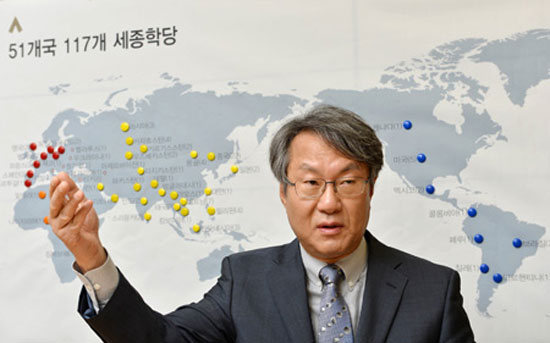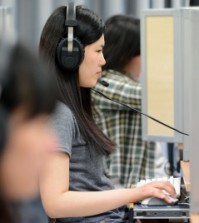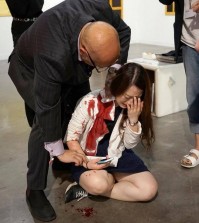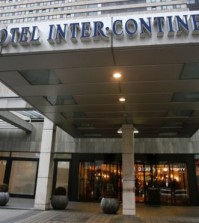- California Assembly OKs highest minimum wage in nation
- S. Korea unveils first graphic cigarette warnings
- US joins with South Korea, Japan in bid to deter North Korea
- LPGA golfer Chun In-gee finally back in action
- S. Korea won’t be top seed in final World Cup qualification round
- US men’s soccer misses 2nd straight Olympics
- US back on track in qualifying with 4-0 win over Guatemala
- High-intensity workout injuries spawn cottage industry
- CDC expands range of Zika mosquitoes into parts of Northeast
- Who knew? ‘The Walking Dead’ is helping families connect
King Sejong Institute promotes Korean language education
Leading ‘hallyu’ foundation marks first anniversary today

Song Hyang-keun, president of the King Sejong Institute Foundation (KSIF), gestures as he speaks on the foundation’s aims and goals at a recent interview with The Korea Times held at the foundation’s office in
Seoul. Behind him are the colored markers that show the 117 King Sejong Institutes located over 51 countries.
(Korea Times photo by Shim Hyun-chul)
By Chung Hyun-chae
“When people are considering learning Korean, we hope that they will think of The King Sejong Institute first, just as Alliance Francaise provides French language education and the Goethe Institute, German,” said Song Hyang-keun, head of the King Sejong Institute Foundation (KSIF).
“Our main goal is to become the institute associated with Korean language education,” said Song.
With demand growing for people to learn the Korean language, the institutes were established in 2009 to share the work of the 27 Korean Cultural Centers overseas.
Then as the institutes grew in number, the KSIF, a public institution, was founded last year to direct the 117 King Sejong institutes located in 51 nations. The name of the institute originates from King Sejong of the Joseon-era, who is revered because of his contribution to the creation of “hangeul,” the Korean alphabet.
It’s a long way from when Song first became interested in teaching Korean in Helsinki in 1999 when he was a visiting professor there.
“The number of students was about 20 per semester back then, “Song said, adding that Taru Salminen, who appeared on the KBS talk show “Beauties’ Chatter Box,” a few years ago, was one of his students.
“Thanks to the 1988 Seoul Olympics, many foreigners gained an interest in Korea. Rapid economic growth in the 1990s acted like fuel on this flame. Although the number of students dwindled in 1997-98, during the Asian financial crisis, it soon rebounded due to the K-pop boom in 2000s,” said Song.
During the interview Song chose to use the term “Korean language,” instead of “hangeul,” in an effort to expand interest in the language. “We try to not only educate people about the Korean alphabet, but also Korea, the country. This kind of education has a long lasting effect,” he said.
The King Sejong Institute runs cultural education programs tailored for each branch. This year, a group of leading students from 43 respective nations visited Seoul from Oct. 4 through Oct. 10.
The main reason non-Korean speakers go to the King Sejong Institute is because of cultural interest. According to a survey of 46 branches in 29 nations, conducted by KSIF earlier this year, about 34 percent of enrolled students attributed their curiosity to Korean pop culture, while approximately 20 percent of them cited interest in the country.
But the interest in K-pop culture is just one ― albeit big ― aspect to the growing demand for the teaching of the Korean language. There are various reasons why foreigners learn the Korean language, and the institute tries to meet the varying needs.
“For example, immigrant workers should take a Korean language examination before entry, but the level is not that high, while foreign brides need to learn practical language skills. Responding to what all students want to learn is difficult work,” said Song.
The institute also takes the languages, cultures, religions and laws of other countries into consideration when teaching Korean.
“We take different approaches for different mother tongues. Chinese people, for example, have difficulties pronouncing ‘ㄹ,’ or ‘rieul,’ which is part of the Korean alphabet with a similar sound to ‘r,’” said Song.
Each branch of the King Sejong Institute has produced a workbook tailored for every region. But prior to that, all students must master a standardized textbook, the “Sejong Korean Language.”
“It is for students who have taken basic classes in another country to enable them to continue their studies even in other branches and countries,” said Song.
Students can also download schoolbook content through an online website “Sejong Nuri,” from all over the world.
This year, the institutes have focused on improving the quality of education and ensuring unif0rm standards. “Quality of education never goes beyond that of teachers,” said Song, who didn’t think that teachers of Korean language have to be Korean.
“No matter where a person is from, teachers should be systemically educated,”
Add to this, the fact that each institute must undergo a rating system that can help overseas branches boost competitiveness.
Yet, the foundation does not yet have deep pockets, and faces challenges from existing teachers of the Korean language around the world.
“We hope that Korean companies, more of which are making inroads into different countries, will work with us,” said Song. “Also, Sejong Institutes aim to go to places where there aren’t yet Korean language programs.”
















